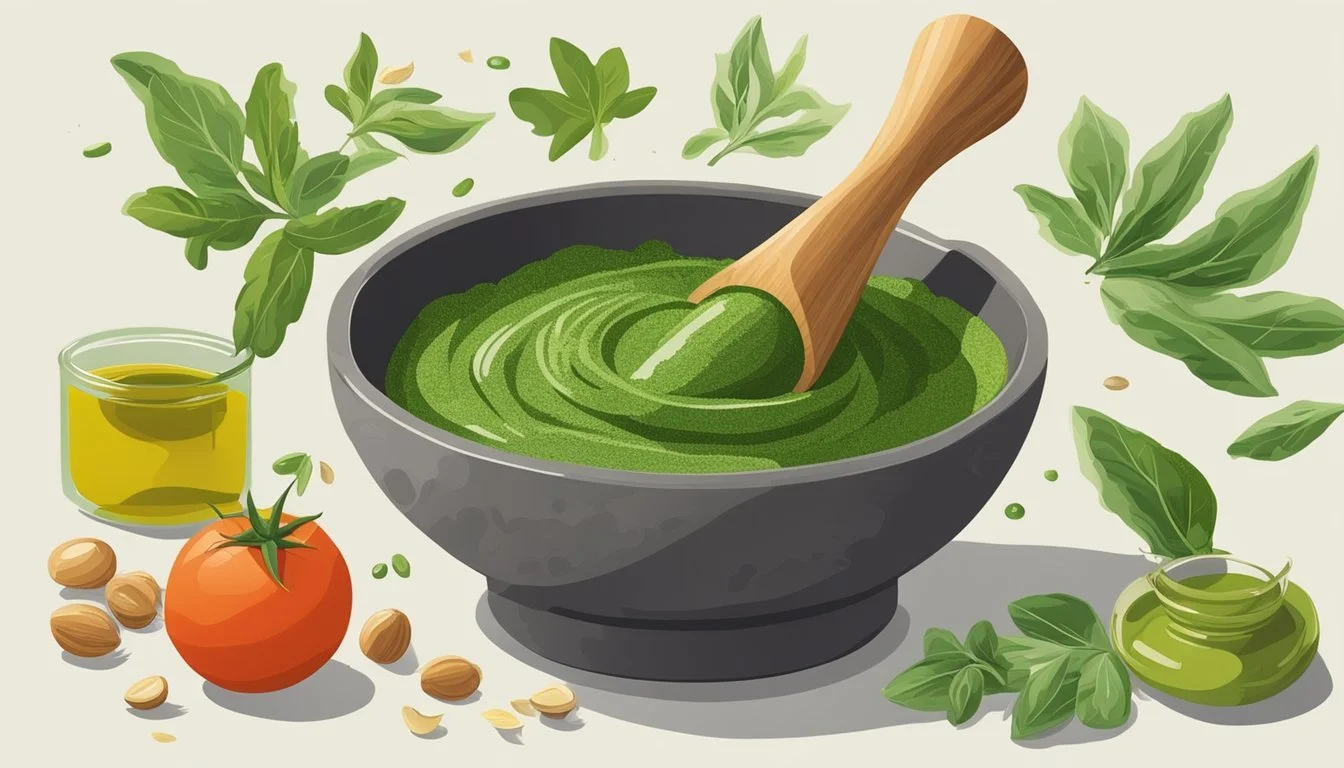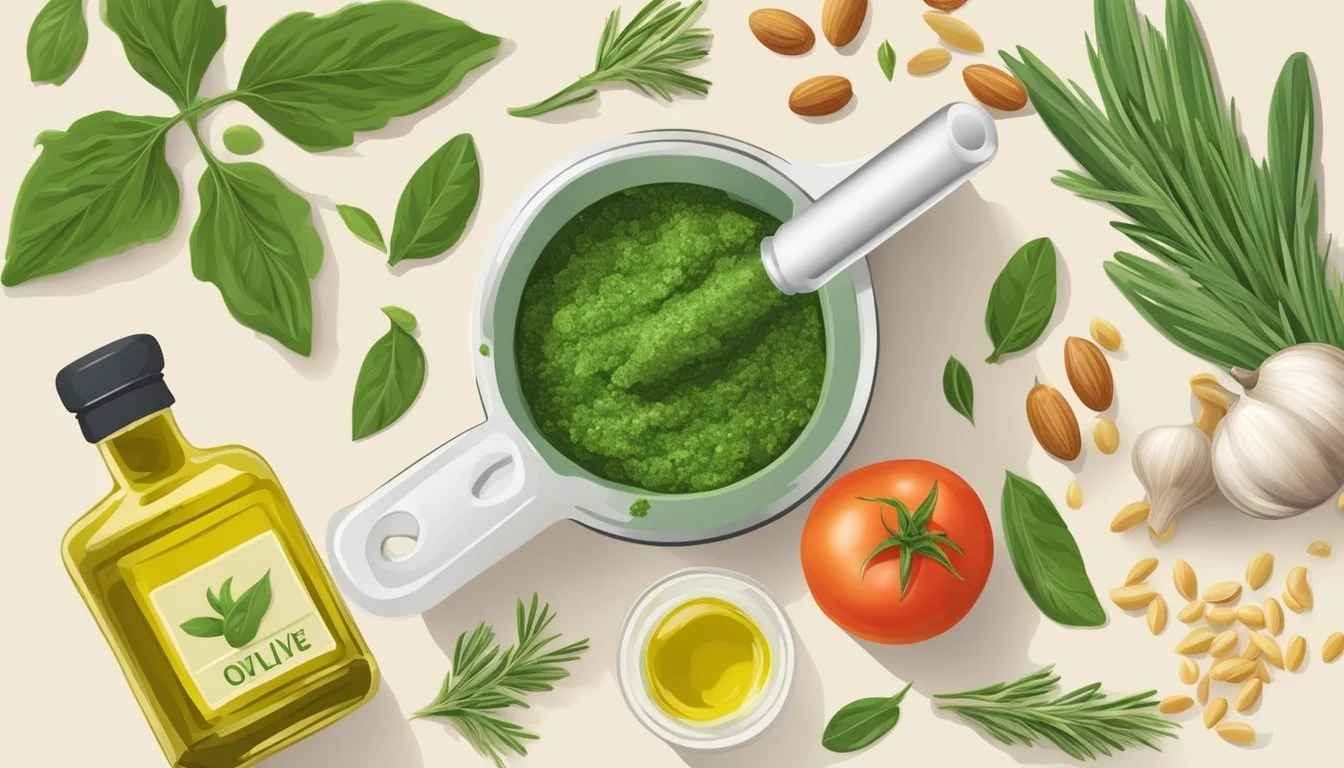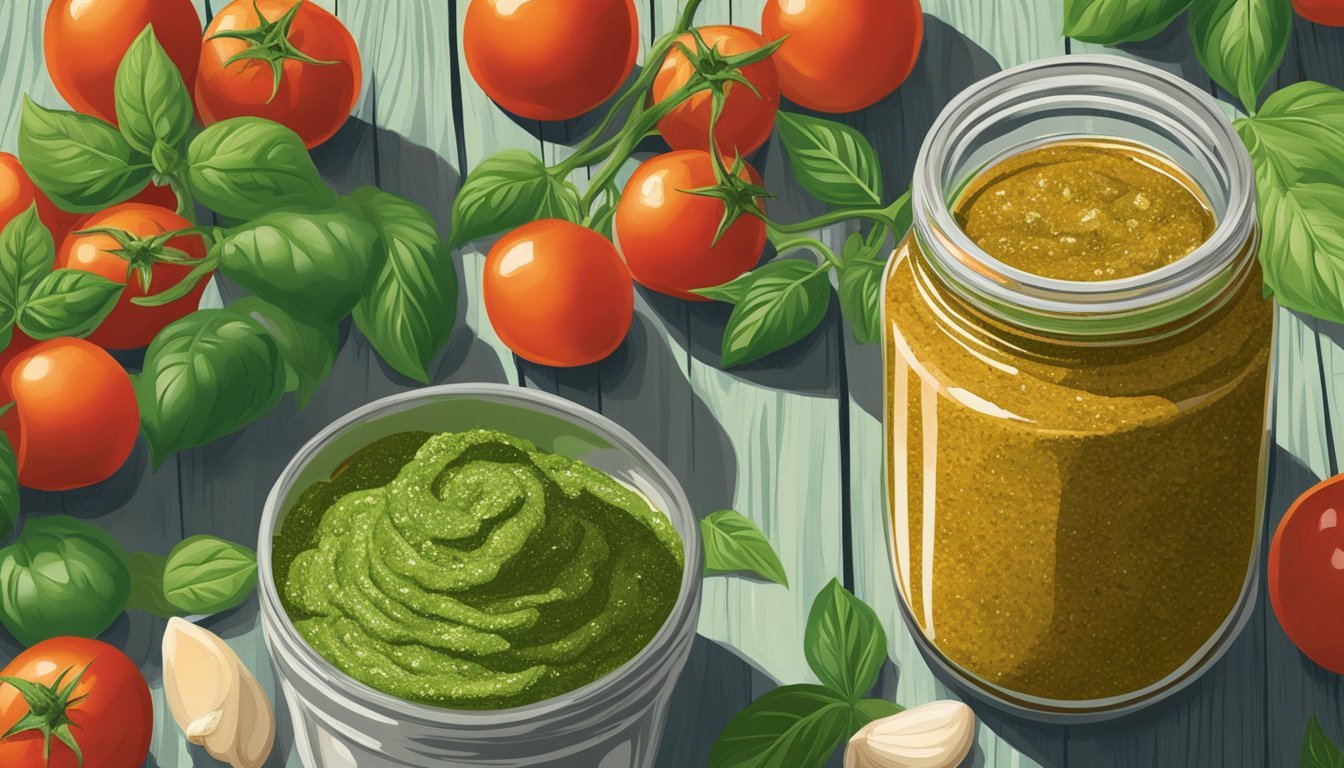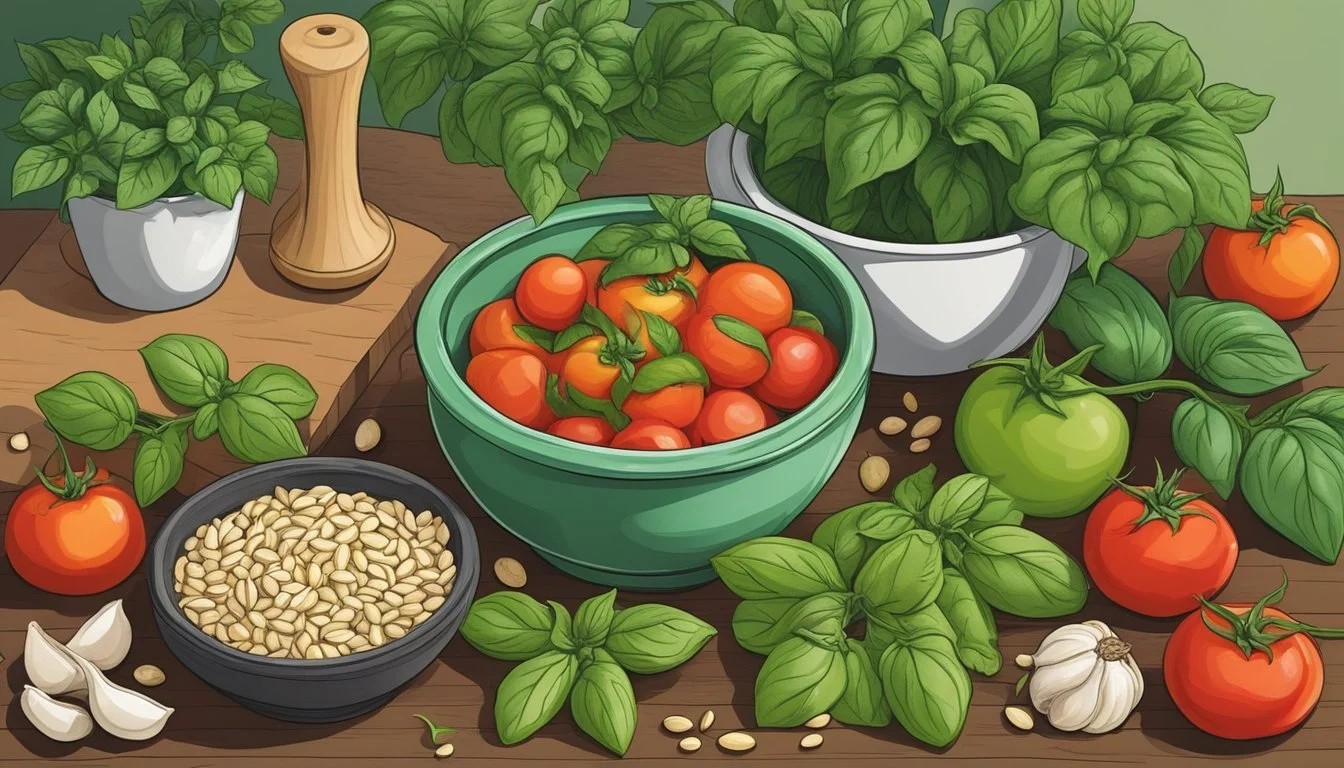Tomato Leaf Pesto
A Unique, Savory Spread for Culinary Adventurers
Tomato Leaf Pesto represents a unique twist on the traditional pesto, introducing a fresh and savory dimension to this beloved spread. The use of tomato leaves, which are typically discarded, imparts a distinctive flavor that embodies the essence of the tomato plant itself. This innovative version of pesto capitalizes on the aromatic qualities of the leaves, offering a culinary experience that is both familiar and novel.
Though not as commonly utilized as other parts of the tomato plant, the leaves are edible and can be transformed into a delicious and savory spread when prepared correctly. Tomato Leaf Pesto incorporates the bright, verdant notes of the leaves, complemented by the traditional ingredients like garlic, Parmesan, and nuts. The result is a spread that can be used in a multitude of dishes, from pastas to crostinis, enriching each with a herby richness that is both comforting and sophisticated.
The creation of Tomato Leaf Pesto showcases the ingenuity of modern cooking techniques, which allow for the exploration of unconventional ingredients to elevate everyday meals. The spread is a testament to the versatility of pesto and the potential of tomato leaves, as it offers a delectable alternative to the classic basil pesto, proving that innovation in the kitchen can lead to the discovery of exciting new flavors.
The Basics of Tomato Leaf Pesto
Tomato leaf pesto emerges as a unique spread that incorporates the bright flavor and aromatic qualities of tomato leaves into a traditional pesto base.
Defining Tomato Leaf Pesto
Tomato leaf pesto is a variant of the classic pesto, where the key ingredient is tomato leaves. In this preparation, the leaves lend a distinct, herbaceous flavor that is not typically found in the more common basil pesto. They are combined with ingredients such as garlic, nuts (often pine nuts or almonds), and cheese (like Parmesan or strong cheddar), all bound together with olive oil. The result is a savory spread that’s perfect for use on pastas, bruschetta, or as a unique condiment.
Safety Concerns and Tips
When incorporating tomato leaves into pesto, safety is crucial since, traditionally, tomato leaves are regarded with caution due to their belonging to the nightshade family, which contain compounds that can be toxic. However, in small quantities, as used in pesto, they are generally safe for consumption. The following tips should be adhered to:
Select leaves: Choose young, fresh leaves from the top of the tomato plant, which tend to have a milder taste.
Proper washing: Clean the leaves thoroughly to remove any potential residue or dirt.
Quantity: Use them sparingly within the pesto to ensure the flavor is balanced and not overwhelming.
Knowledge: It's essential to have an understanding of which leaves are suitable for culinary uses, and those with allergies or sensitivities should exercise extra caution.
Ingredients Breakdown
Tomato leaf pesto is a savory spread that relies on a harmonious blend of select ingredients. The choice of components brings out the pesto's distinct flavor, making it a versatile addition to various dishes.
Essential Ingredients for Flavor
The foundation of any pesto includes fresh basil, garlic, and extra virgin olive oil. These ingredients impart the classic pesto taste:
Fresh Basil: Provides a sweet and peppery essence.
Garlic: Adds pungency and depth.
Extra Virgin Olive Oil: Offers a fruity base and binds the pesto together, contributing a smooth texture.
Salt and pepper are used to enhance these flavors, with salt bringing out the natural sweetness of the tomato leaves and pepper adding a slight heat.
Cheese Varieties and Vegan Substitutes
Traditionally, Parmesan cheese is used for its salty and nutty profile which complements the herbal notes.
Parmesan Cheese: Aged for a rich, complex flavor.
For a vegan alternative, nutritional yeast can be used to replicate the umami quality of cheese:
Nutritional Yeast: Offers a cheesy flavor while keeping the pesto vegan.
Options for Nuts and Substitutes
Nuts add a creamy texture and rich taste. The following can be used:
Pine Nuts: Traditional choice with a buttery flavor.
Walnuts: Provide an earthier note.
Almonds: Contribute a sweeter taste and crunchier texture.
The nuts may be toasted to intensify their flavors and add a hint of smokiness to the pesto. Each nut has unique attributes that can be tailored to personal preference or dietary needs.
Preparation Techniques
The success of Tomato Leaf Pesto hinges on achieving the ideal consistency and texture, which can be masterfully obtained through proper processing techniques.
Using a Food Processor
For those who prefer speed and ease, a food processor is the tool of choice. One should start by adding the base ingredients—basil, Parmesan, tomato leaves, pine nuts, and garlic—into the bowl of the processor. Pulse until the ingredients are finely chopped and crumbly, ensuring to scrape down the sides periodically to integrate all elements thoroughly. While continuing to pulse, gradually add olive oil in a steady stream to reach a creamy mixture, tailored to your preferred consistency and texture.
Alternative Tools
In the absence of a food processor, alternative methods can yield equally flavorful results. A mortar and pestle can be utilized for a more hands-on approach, grinding the solid components first to a desired granular texture before blending in the olive oil. This method may involve a bit more effort, but some argue that the resulting texture of the pesto is superior and retains more flavor.
Pesto Recipe Variations
Pesto is a versatile spread that invites experimentation in its recipes. This section explores the different approaches one can take with traditional pesto as well as variations that feature tomato leaves.
Traditional Versus Tomato Leaf Pesto
Traditional pesto, or basil pesto, is a savory spread known for its sweet and tangy flavor profile, typically made with fresh basil, garlic, pine nuts, Parmesan cheese, and olive oil. In contrast, tomato leaf pesto takes advantage of the aromatic leaves of the tomato plant, which impart a unique and bold taste to the pesto. One must be careful to use tomato leaves in moderation, as they can contain toxins in larger amounts. The key differences are:
Flavor Base: Basil provides a sweet, peppery base, while tomato leaves offer an earthy and robust flavor.
Texture: Both utilize nuts and cheese, but tomato leaf pesto may have a slightly coarser texture.
Use: Traditional pesto is commonly paired with pasta, whereas tomato leaf pesto can be a distinct spread on bruschetta or a marinade.
Incorporating Other Herbs
While basil is the cornerstone of traditional pesto, incorporating other greens such as spinach, arugula, or cilantro can create new flavor dynamics:
Spinach: Adds a mild, slightly earthy flavor and results in a creamier pesto.
Arugula: Introduces a peppery kick to the pesto, perfect for those seeking a sharper taste.
Cilantro: Imparts a citrusy, pungent note, lending a Mexican flair to the pesto.
By adjusting the herb base and combining it with ingredients like nuts, garlic, cheese, and olive oil, one can craft a spread that suits their specific taste preferences while still honoring the essence of a pesto. Here is a simple breakdown of herbs and their characteristics:
Herb Flavor Note Best Paired With Basil Sweet, peppery Traditional pine nuts Tomato Leaf Earthy, robust Walnuts, almonds Spinach Mild, earthy Pecans, walnuts Arugula Peppery, sharp Pine nuts, almonds Cilantro Citrusy, pungent Cashews, macadamias
Gardeners and chefs alike can enhance their pesto recipes by exploring these variations, creating spreads that are as unique as they are delicious.
Serving and Pairings
Tomato leaf pesto offers a delightful twist on traditional pesto with its robust and earthy flavors, (What wine goes well with earthy flavors?) making it an ideal accompaniment to a variety of dishes. Its bold taste and unique aroma enhance the overall experience of the meal.
Pasta and Tomato Leaf Pesto
For pasta enthusiasts, incorporating tomato leaf pesto as a pasta sauce can transform a simple meal into a gourmet experience. The serving suggestion is to mix the pesto with your favorite cooked pasta, allowing the warmth to release the flavors. Thin it with a bit of pasta water if necessary for the right consistency. Pair with a sprinkle of Parmesan cheese for an added depth of flavor.
Pasta Pairings:
Penne: Ideal for capturing the pesto in its ridges
Spaghetti: Simple yet classic choice
Farfalle: Provides a unique texture
Spread for Sandwiches and Crackers
Tomato leaf pesto shines as a spread on a variety of sandwiches, providing a savory layer that complements both meats and vegetables. It also serves well as a dip with artisan crackers or crostini for a quick, flavorful snack.
Sandwich Suggestions:
Grilled chicken with tomato leaf pesto on ciabatta
A mozzarella, tomato, and pesto panini for a caprese-inspired lunch
For Crackers and Crostini:
A dollop of pesto on crostini, topped with a cherry tomato
As a dip for a charcuterie (What wine goes well with charcuterie?) board's selection of crispy crackers
Creative Uses in Dishes
Chefs can be innovative with tomato leaf pesto by using it in various dishes beyond the expected. It adds a complex flavor to a pesto chicken marinade or as a topping on homemade pizza. Even a caprese salad (What wine goes well with caprese salad?) can be elevated with a spoonful of tomato leaf pesto drizzled over fresh mozzarella and ripe tomatoes.
Innovative Ideas:
Spread on pizza: Before adding cheese and tomato slices
Pesto chicken: Use as a marinade before roasting
Caprese salad: Drizzle over the top for a fragrant twist
By integrating tomato leaf pesto into these diverse serving options, diners can enjoy a spread that is both distinct and versatile, enhancing the taste of many staple dishes.
Storage and Preservation
Proper storage techniques ensure the longevity and freshness of tomato leaf pesto, allowing one to enjoy this savory spread beyond its immediate use. There are two primary methods: short-term refrigeration for frequent use, and longer-term freezing for future enjoyment.
Short-term Refrigeration
For short-term storage, one should place the pesto in an airtight container and store it in the fridge. This method keeps the pesto fresh for approximately 5 to 7 days. To ensure the best quality, the container should be positioned in the coldest part of the refrigerator, such as the back of a shelf, away from the door.
Instructions:
Transfer pesto to an airtight container.
Secure the lid tightly to prevent exposure to air.
Place in the coldest section of your refrigerator.
Freezing for Longevity
When preserving tomato leaf pesto for extended periods, freezing is the most effective method. It can maintain the quality of the pesto for several months. One efficient approach is to use ice cube trays allowing one to thaw smaller portions as needed.
Steps:
Fill ice cube trays with pesto.
Smooth the surface with a spoon for even freezing.
Once frozen, transfer the pesto cubes to a resealable bag, ensuring to remove excess air.
Label the bag with the date and return it to the freezer.
This system not only extends the life of the pesto but also minimizes waste by enabling one to thaw only the required amount.
Nutritional Information
Tomato leaf pesto offers a blend of nutrients that contribute to a balanced diet, with a particular emphasis on heart-healthy fats and moderate protein content. Its unique components yield different nutritional benefits.
Macronutrients and Calories
Calories: A serving size of tomato leaf pesto typically contains about 250-300 calories, largely influenced by the oil and nuts contained within.
Fat: The composition of fats is generally healthy, with monounsaturated and polyunsaturated fats present from olive oil and nuts. It averages around 20-25 grams per serving, with a saturated fat content of around 3-5 grams.
Protein: This pesto variation has moderate protein levels, around 5-7 grams per serving, contributed by cheese and nuts.
Carbohydrates: Carbohydrates are generally low in pesto, estimated at 3-6 grams per serving.
Fiber: Provided by the tomato leaves and nuts, it can range from 1-2 grams per serving.
Cholesterol: Due to the cheese content, cholesterol may be present, typically around 5-15 milligrams per serving.
Considerations for Dietary Restrictions
Vegan Diet: Traditional tomato leaf pesto includes cheese, which is not suitable for vegans. However, using nutritional yeast or vegan cheese substitutes can provide a similar flavor profile and make it vegan-friendly.
Gluten-Free: Pesto is inherently gluten-free as it does not contain wheat or other gluten-containing ingredients.
Dairy-Free: Similar to vegan adjustments, dairy-free alternatives can be used to eliminate cheese, making the pesto suitable for those with dairy restrictions.
Tips and Tricks for Perfect Pesto
In the art of pesto making, particularly with the innovative twist using tomato leaves, the essence lies in flavor balance and textural finesse. Achieving the perfect harmony and consistency ensures a pesto that not only tantalizes the taste buds but also pairs wonderfully with a variety of dishes.
Achieving the Right Flavor Balance
Use Fresh Basil Leaves: The foundation of any pesto is basil. Fresh basil leaves provide a vibrant and aromatic quality that is unparalleled. To ensure the flavor is not overpowering, one may consider a ratio of 2:1, basil to tomato leaves, as a starting point.
Acidity is Key: A squeeze of lemon juice not only adds a touch of brightness but also helps to preserve the green color of the pesto. Aim for about one tablespoon of lemon juice to balance the flavors.
Salt Selection: Sea salt tends to have a more nuanced flavor compared to kosher salt, has a slightly coarser texture which can aid in breaking down the leaves if using a mortar and pestle. One should season gradually, tasting as they go to achieve the desired saltiness.
Texture and Consistency Adjustments
Olive Oil Gradation: Quality olive oil contributes to a smooth texture and rich taste. Begin with a slow drizzle, ultimately using just enough to achieve a creamy consistency that still holds body. Approximate guidance is 1/2 cup of olive oil per 2 cups of combined basil and tomato leaves.
Cheese for Body: Grated Parmesan adds depth and a touch of richness. The amount can be adjusted to preference, but start with about 1/2 cup per 2 cups of leaves.
Water for Smoothness: If a thinner consistency is desired without increasing oil content, a little water can be incorporated. However, one must use a sparing amount to avoid diluting the flavors too much.
By following these focused tips and making subtle adjustments, one can craft a tomato leaf pesto with an exceptional flavor balance and an ideal consistency that's perfect for spreading, tossing with pasta, or using as a dip.
Beyond the Spread: Versatile Applications
Tomato leaf pesto, with its unique savory flavor, transcends beyond being just a spread. Its versatility shines when it serves as a robust base for other creations and imbues its distinct taste into various dishes through infusions and marinades.
Pesto as a Base for Other Sauces
When one considers tomato leaf pesto as a base, a myriad of possibilities unfold. For a Mediterranean twist, incorporating elements such as olives or capers can transform it into a complex red pesto sauce ideal for summer fares. Sun-dried tomato pesto, known for its concentrated tomato flavor, can be achieved by blending in finely chopped sun-dried tomatoes, creating a richer and deeper pesto variant suitable for robust pesto recipes.
Base Enhancement:
Olives or capers: Mediterranean flavor
Sun-dried tomatoes: Intensify tomato profile
Infusions and Marinades
The pesto lends itself as a flavorful marinade that can permeate proteins such as chicken or shrimp, infusing them with herbaceous tones for grilling or roasting. Veggies, whether grilled or roasted, benefit greatly from being tossed in tomato leaf pesto, making the most of the summer bounties. The pesto's aroma and taste are well-suited for both meat and vegetarian dishes (What wine goes well with vegetarian dishes?), reaffirming its versatility.
Marinade Matches:
Chicken: Herbed & savory
Shrimp: Aromatic & zesty
Veggies: Enhanced summer produce
By considering tomato leaf pesto for these applications, one unlocks innovative culinary uses that enrich various dishes with flavor.











